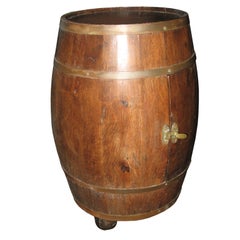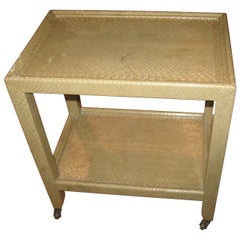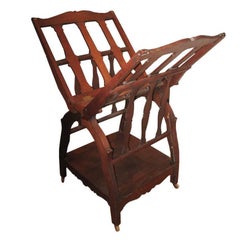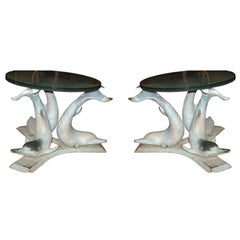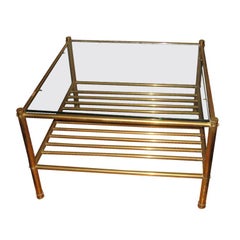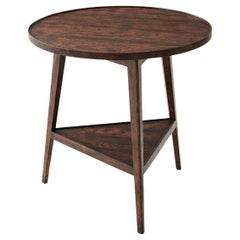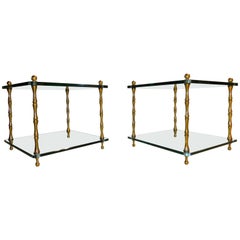Eclectiques End Tables
to
Height
to
Width
to
Depth
to
5
5
1
4
1
1
1
1
3
3
2
1
1
2
2
2
1
1
5
5
5
1
Oak and Brass Smoking Table
Located in Water Mill, NY
Handmade oak and brass smoking table that has a pipe rack on door.
Category
Early 20th Century English End Tables
Materials
Oak
Karl Springer Snakeskin Telephone Table
By Karl Springer
Located in Water Mill, NY
Karl Springer signed snakeskin telephone table on brass
wheels. In pale yellow
Category
Late 20th Century End Tables
Materials
Serpentine, Brass
19th Century Folio Stand
Located in Water Mill, NY
Late 19th century walnut folio stand with under shelve and wooden wheels. Measures: 48" open.
Category
Antique 19th Century American Magazine Racks and Stands
Materials
Walnut
$2,800
Pair of Bronze Dolphin Bases
Located in Water Mill, NY
Pair of bronze dolphin bases-with excellent green patina, Hampton location.
Category
20th Century American End Tables
Materials
Bronze
$2,900 / set
Pr. of Mid-Century Italian Brass Two Tier Side Tables
Located in Water Mill, NY
Pair of Italian Two Tier Side Tables with Glass Tops,
superbly made-heavy gage brass-Hampton Location
superbly made-heavy gage brass-Hampton Location
Category
Vintage 1960s Italian Side Tables
Materials
Brass
Related Items
Oak and Mahogany Cricket Table
Located in Westwood, NJ
An English reclaimed oak veneered and mahogany cricket table, the circular planked top with a raised edge, on three splayed tapering legs joined by a triangular undertier.
Dimensi...
Category
21st Century and Contemporary Vietnamese Rustic End Tables
Materials
Wood
Baker Furniture Company Brass Tables Mid Century Two-Tiered Glass Shelves 1960s
By Baker Furniture Company
Located in Camden, ME
Baker Furniture Company pair of faux bamboo brass two-tiered glass top side tables in bronze lacquer.
Modulating cast metal supports add a classical twist to these understated table...
Category
Mid-20th Century Italian Mid-Century Modern End Tables
Materials
Brass
$2,240 Sale Price / set
20% Off
H 16.5 in W 18 in D 18 in
Paul Frankl Two-Tier Side Table for Brown Saltman
By Paul Frankl, Brown Saltman
Located in Los Angeles, CA
Paul Frankl two-tiered occasional table by Brown Saltman of California, circa 1950.
Solidly crafted and elegantly designed.
Signed and marked.
We have not refinished or restore...
Category
Vintage 1950s American Mid-Century Modern Side Tables
Materials
Maple
Herbst for Stablet Pair of Side Tables in Brass & Oak, France 1950's
By René Herbst
Located in New York, NY
Elegant pair of forged brass and carved oak side tables by René Herbst for Stablet. The tops are dished out to prevent glasses from slipping off, which is a great feature for enterta...
Category
Mid-20th Century French Mid-Century Modern End Tables
Materials
Brass
Karl Springer 1986 Python Snakeskin Telephone Table Signed & Dated
By Karl Springer
Located in Bridgeport, CT
Karl Springer two-tiered design is commonly referred to as a "Telephone Table" by Karl Springer, a design he produced in various skins and finishes. This particular table with snake...
Category
20th Century American Mid-Century Modern Tables
Materials
Brass
Oak Parquetry Round Side Table, Dark Oak
Located in Westwood, NJ
A dark oak parquetry round side table with tapered oak legs. This beautiful round two-tier side table has an arranged radial design on its oak parquetry top and shelf.
Shown in dusk...
Category
21st Century and Contemporary Vietnamese Neoclassical End Tables
Materials
Wood
Karl Springer 1991 Snakeskin Telephone Table Signed & Dated
By Karl Springer
Located in Bridgeport, CT
Classic Karl Springer two-tiered design is commonly referred to as a "Telephone Table", a design he produced in various skins and finishes. This particular table with snakeskin fin...
Category
1990s American Mid-Century Modern Side Tables
Materials
Brass
Arts and Crafts Oak Table
Located in Greenwich, CT
An Arts and Crafts table in quarter sawn oak with hexagonal top and shaped undershelf supported on three flat tapered legs ending in arched feet and decorated with trefoil piercework...
Category
Antique Early 1900s English End Tables
Materials
Oak
Italian Rectangular 2-Tier Brass End or Side Table
Located in Palm Springs, CA
Italian brass 2-tier rectangular side or occasional end table, with newer dark tinted glass insert tops. Unique design with bowed cabriole style legs. Solid heavy brass construction.
Category
Vintage 1960s Italian End Tables
Materials
Brass
Two Tier Marble Glass Brass Side Table After Ponti
By Gio Ponti
Located in New York, NY
Chic, architectural two tier side table having a plate glass top, over a second level marble shelf, all supported by brass vertical elements.
The top glass shelf is 23.5 H, lower ma...
Category
Mid-20th Century American Mid-Century Modern Side Tables
Materials
Marble, Brass
Mid-Century Modern Octagonal Two Tiered Side End Table Adrian Pearsall for Lane
By Lane Furniture, Adrian Pearsall
Located in Lambertville, NJ
Sculptural Mid-Century Modern octagonal side, end or drinks table by Lane Furniture. Sleek and stylish and very unique. Features gorgeous walnut wood frame with a beautiful parquetry...
Category
Vintage 1970s Mid-Century Modern Side Tables
Materials
Wood
$750
H 20 in W 25.5 in D 25.5 in
Small Classic Two-Tier Side Table, Drift White
Located in Westwood, NJ
Small Classic rectangle two-tier side table with lipped top, tapered legs, and a shelf, has a “rustic” warm brown finish with subtle visual ...
Category
21st Century and Contemporary Vietnamese Neoclassical End Tables
Materials
Wood
